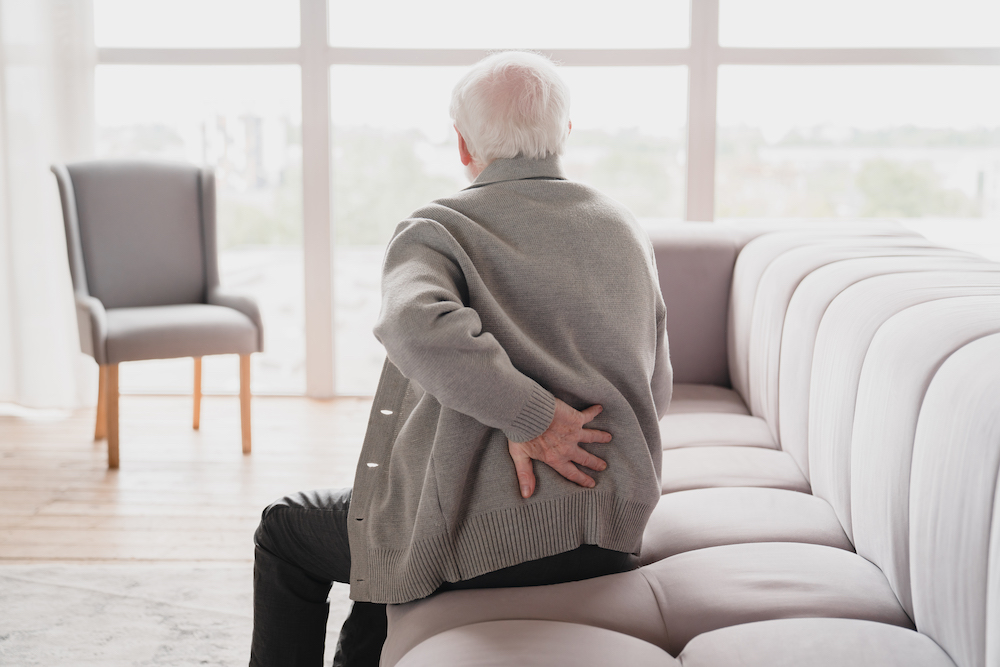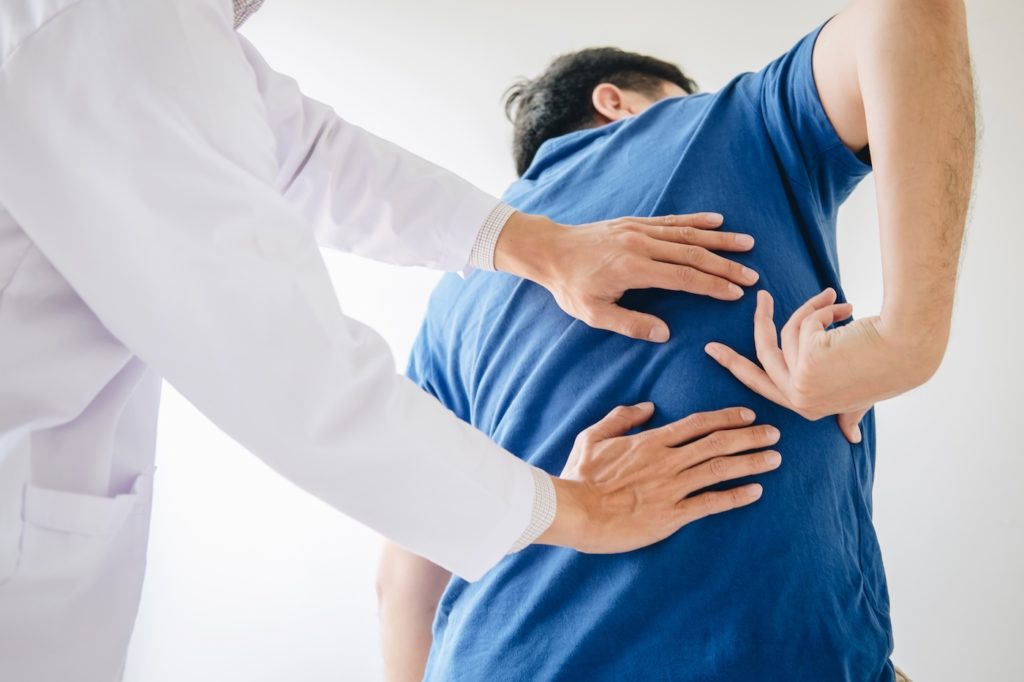
Lower back pain is a widespread and often debilitating condition that affects millions of people around the globe. Regardless of your age, gender, or occupation, most of us will experience lower back pain at some point in our lives.
While some patients experience mild discomfort that naturally improves with time, others have more persistent and severe pain. When pain holds you back from work, daily activities, or social functions, it’s important to seek medical treatment.
Kansas City Orthopedic Alliance is the Midwest’s premier provider of orthopedic care. As the largest orthopedic practice in Kansas City, we treat thousands of patients each year across our 5 locations: Overland Park, Leawood, Belton, Kansas City, and Blue Springs. Using the latest technology, our physicians can evaluate, diagnose, and treat nearly any type of musculoskeletal injury.
Lower back pain is one of the most common musculoskeletal complaints we address in clinical practice. Our team of orthopedic surgeons, physicians, and advanced practice providers is dedicated to helping patients overcome pain to improve their well-being and quality of life.
While any type of lower back pain can hold you back, lumbar radiculopathy is a specific type of pain associated with the nerves in the lower back. This pain can lead to numbness, tingling, and weakness that radiates down one or both legs.
At KCOA, we offer lumbar radiculopathy treatment in Kansas City. If you’re ready to find relief from your pain, schedule an appointment with an orthopedic provider today.
If you want to learn more about the causes, symptoms, and treatments for lumbar radiculopathy, keep reading for advice from our experts.
What Is Lumbar Radiculopathy?
Lumbar radiculopathy (also known as sciatica), is a condition that affects up to 5% of the population. This painful condition is often caused by the compression or irritation of the largest nerve in the body—the sciatic nerve.
Lumbar radiculopathy can lead to a number of unwanted symptoms, including:
- Lower back pain
- Shooting pains or “electrical shocks” that radiate from the buttocks to the foot
- Tingling and numbness in the leg or foot
- Weakness in the leg or foot (i.e. difficulty lifting your foot or moving your toes)
- Sharp pain while sitting
- Pain when coughing
To better understand lumbar radiculopathy and what causes this pain, it’s important to understand the key anatomical structures of the spine.
The Anatomy of the Spine
The spine is a complex structure that provides support for our body. Several components make up the spine, including:
Vertebrae
Individual bones, called vertebrae, make up the spine. There are 33 vertebrae total, and they are divided into regions. Lumbar radiculopathy affects the lumbar spine, which is the 5 vertebrae of your lower back.
Intervertebral Discs
Between every vertebra, there is soft tissue called the intervertebral discs. These structures act as a cushion or shock absorber for the spine, allowing for movement and flexibility.
Vertebral Canal
The vertebral canal is a hollow space that runs through the center of the spine. This space is designed to house and protect the spinal cord.
Nerves
Nerves are the structures that communicate messages between your brain and different parts of your body. Nerves branch off of the spinal cord and pass through openings in the vertebrae.
Sciatic Nerve
The sciatic nerve is the longest nerve in your body, starting at the lower back and running down each leg.
Understanding Lumbar Radiculopathy
Now that you are familiar with the structures of the spine, it will be easier to understand the causes of this condition and our approach to lumbar radiculopathy treatment in Kansas City.
Causes of Lumbar Radiculopathy
Lumbar radiculopathy can be the result of any condition that compresses nerves in your lower back. This can include:
A Herniated Disc
A herniated disc is when the soft, inner core of an intervertebral disc pushes through the exterior casing. Sometimes herniated discs don’t cause any symptoms, but other times they can press against nearby nerves and cause problems.
When a herniated disc occurs in the lumbar spine, it can compress the nerves of the lower back, leading to sciatica.
Bone Spurs
A bone spur is a bony growth that can develop on the ends of bones. Bone spurs can appear due to a variety of factors, including aging, osteoarthritis, and even genetics.
If a bone spur develops in the lumbar spine, it can narrow the space where the nerve exits the spinal cord. This narrowed space can cause compression of the nerve and lead to radiculopathy.
Spinal Stenosis
Spinal stenosis is the narrowing of the space in the vertebral canal. Spinal stenosis is a natural process that often occurs with age, but it can also be the result of injuries, osteoarthritis, tumors, and more.
When lumbar stenosis occurs, it can put pressure on the nerves and lead to lumbar radiculopathy.
Compression Fractures
Lumbar radiculopathy can occur when a vertebra is fractured (also known as a broken bone). This usually occurs after trauma, such as a motor vehicle accident or a fall. It can also happen due to conditions that weaken bones, such as osteoporosis.
Spinal Tumors
Although a less common cause of lumbar radiculopathy, spinal tumors can be the cause of this condition. If a tumor (benign or malignant) grows near the vertebral canal, it can put pressure on or displace the nerve roots in the lumbar spine.
Poor Posture
Certain habits, such as poor posture, can lead to the development of lumbar radiculopathy. Poor posture can lead to spinal misalignment, increase pressure on the vertebral discs, and alter the natural curvature of the spine—all leading to nerve compression.
Excess Body Weight
Carrying extra body weight puts a lot of stress on the lower back. This increased pressure can cause discs to degenerate, inflammation to occur, and lead to other conditions that cause spinal stenosis and nerve compression.
It is essential to find the root cause of your sciatica pain, as it will help determine your lumbar radiculopathy treatment in Kansas City.
Diagnosing Lumbar Radiculopathy
If lumbar radiculopathy pain is interfering with your life, it’s important to seek medical treatment from an orthopedic provider who can find the root of the problem.

Your provider will start with a thorough history and physical exam. Based on the exam results and your symptoms (and how long the symptoms have been present), your doctor may recommend diagnostic imaging.
MRI is usually the preferred imaging method when looking for the cause of lumbar radiculopathy. CT scans can also be helpful; however, they are not as sensitive in visualizing soft tissue and tumors. X-rays may be used to visualize gross bony abnormalities causing your pain.
Lumbar Radiculopathy Treatment in Kansas City
At KCOA, our providers personalize treatment plans to align with your lifestyle and goals.
Noninvasive Treatments
Whenever possible, our providers prefer to start with conservative treatments for pain relief. This could include one or more of the following treatments:
Physical Therapy
Physical therapy can help alleviate nerve compression through:
- Strengthening muscles to provide better support to the spine
- Stretching to improve flexibility and reduce muscle tightness
- Posture correction to minimize stress on the spine
- Heat and cold therapy to reduce pain and inflammation
- Manual therapy to mobilize tissue and joints
Medications
Your doctor may recommend over-the-counter or prescription medications to help manage your pain. You should always talk to your doctor before starting any new medications, even if they are over-the-counter (such as NSAIDS).
Injections
Cortisone, steroid, or epidural injections into the spine can help reduce inflammation and pain for 3 to 6 months. Many patients are able to manage their lumbar radiculopathy through pain injections alone, but keep in mind that they only treat the symptoms—they won’t solve the underlying problem if you have something compressing the nerve root.
Lifestyle Modifications
Lifestyle modifications can also be an effective tool to manage your symptoms. This can include:
- Limiting positions and activities that increase pain (but don’t avoid all movement)
- Modifying activities to reduce strain and nerve compression
- Losing weight to minimize stress on your spine
Surgical Treatments
If we have exhausted all nonsurgical treatment options and you are still experiencing pain, it may be time to discuss surgical lumbar radiculopathy treatment in Kansas City.
Lumbar Microdiscectomy
If a herniated disc is the root of your pain, your orthopedic surgeon may recommend a lumbar microdiscectomy. During this minimally invasive procedure, the surgeon will remove the herniated disc material.
Laminectomy
If the root of your pain is due to the narrowing of your spine (spinal stenosis), a laminectomy or spinal decompression can help open the space in the vertebral canal. During this procedure, the surgeon removes part of the vertebral bone to relieve pressure on the affected nerve.
Visit KCOA for Lumbar Radiculopathy Treatment in Kansas City
At Kansas City Orthopedic Alliance, we’re dedicated to creating a superior patient experience for all. If you are looking for sciatic nerve pain relief in Kansas City, our team will help ensure the best possible outcomes.
We’ve helped thousands of patients treat their pain, restore their function, and improve their quality of life.
For a thorough evaluation, call us at (913) 319-7600 or schedule an appointment today. If you’re struggling with pain but don’t know where to start, use our symptom tracker for treatment recommendations.


